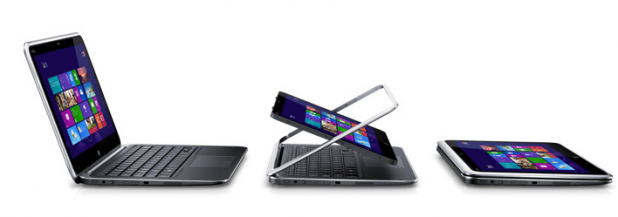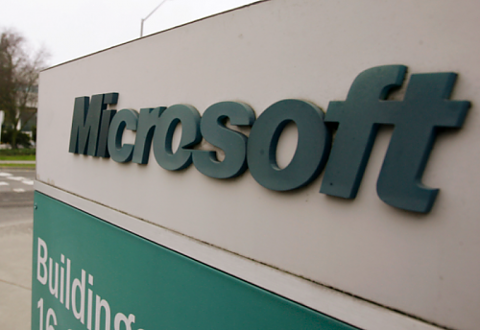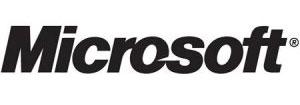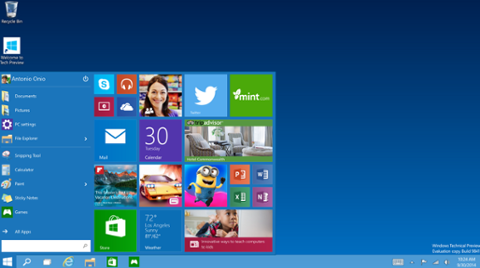 Manufacturers such as Dell have experimented with the laptop form-factor, but most aren't deviating too much from traditional laptops.[/caption] Microsoft had high hopes that Windows 8 would kick off a market for touch-enabled laptops. But that market looks like it’s fizzling out. IDC predicted that 17 percent to 18 percent of laptops released this year would have touchscreens, a number the research firm is now revising downward. “That now looks to be too high, to be honest,” IDC analyst Bob O’Donnell told Computerworld last week. The revised estimate now stands at between 10 percent and 15 percent. That isn’t good news for Microsoft, which was counting on manufacturers to churn out more touch-enabled devices loaded with Windows 8, which features a Start screen optimized for finger-taps and swipes. Many users have found that, without the ability to touch, using much of Windows 8 is simply a pain. Microsoft executives must have thought that Windows 8 would kick off some sort of virtuous cycle, with consumer demand for Windows 8 devices compelling manufacturers to flood the market with touch-screen laptops, hybrids, and tablets—which would convince more customers that the latest version of Windows was indeed the wave of the future. Instead, Windows 8 has failed to meet Microsoft’s sales expectations. In July, Microsoft CEO Steve Ballmer admitted at an internal company event that Windows devices hadn’t been selling well enough, according to a report at the time from Neowin. As part of its most recent quarterly earnings, Microsoft also announced that it would take a $900 million charge against Surface RT devices, its flagship tablets running Windows RT, a version of Windows 8 for tablets that rely on the ARM chip architecture. According to IDC, Windows RT holds 0.5 percent of the tablet market, lagging behind x86-based Windows at 4.0 percent, Apple’s iOS with 32.5 percent, and Google Android with 62.6 percent. With regard to PCs, Net Applications estimates that Windows 8 holds 5.4 percent of the market—well behind the antique-but-sturdy Windows XP at 37.19 percent and Windows 7 at 44.49 percent. The anemic nature of today’s PC market likely killed hardware manufacturers’ appetite for experimenting with touch-screen laptops and hybrid devices; while most released a handful of touch-enabled products around the time of Windows 8’s launch, “traditional” (i.e., non-touch-enabled) laptops and desktops continue to dominate their respective portfolios. Nor is the market flooded with Windows 8 tablets—perhaps a reflection of those manufacturers’ irritation with Microsoft’s decision to build its Surface tablets in-house. In any case, the failure of touch-screens to swallow up a healthy portion of the laptop market in the year following Windows 8’s release bodes darkly for Microsoft, which is already facing troubles on a number of fronts. Image: Dell
Manufacturers such as Dell have experimented with the laptop form-factor, but most aren't deviating too much from traditional laptops.[/caption] Microsoft had high hopes that Windows 8 would kick off a market for touch-enabled laptops. But that market looks like it’s fizzling out. IDC predicted that 17 percent to 18 percent of laptops released this year would have touchscreens, a number the research firm is now revising downward. “That now looks to be too high, to be honest,” IDC analyst Bob O’Donnell told Computerworld last week. The revised estimate now stands at between 10 percent and 15 percent. That isn’t good news for Microsoft, which was counting on manufacturers to churn out more touch-enabled devices loaded with Windows 8, which features a Start screen optimized for finger-taps and swipes. Many users have found that, without the ability to touch, using much of Windows 8 is simply a pain. Microsoft executives must have thought that Windows 8 would kick off some sort of virtuous cycle, with consumer demand for Windows 8 devices compelling manufacturers to flood the market with touch-screen laptops, hybrids, and tablets—which would convince more customers that the latest version of Windows was indeed the wave of the future. Instead, Windows 8 has failed to meet Microsoft’s sales expectations. In July, Microsoft CEO Steve Ballmer admitted at an internal company event that Windows devices hadn’t been selling well enough, according to a report at the time from Neowin. As part of its most recent quarterly earnings, Microsoft also announced that it would take a $900 million charge against Surface RT devices, its flagship tablets running Windows RT, a version of Windows 8 for tablets that rely on the ARM chip architecture. According to IDC, Windows RT holds 0.5 percent of the tablet market, lagging behind x86-based Windows at 4.0 percent, Apple’s iOS with 32.5 percent, and Google Android with 62.6 percent. With regard to PCs, Net Applications estimates that Windows 8 holds 5.4 percent of the market—well behind the antique-but-sturdy Windows XP at 37.19 percent and Windows 7 at 44.49 percent. The anemic nature of today’s PC market likely killed hardware manufacturers’ appetite for experimenting with touch-screen laptops and hybrid devices; while most released a handful of touch-enabled products around the time of Windows 8’s launch, “traditional” (i.e., non-touch-enabled) laptops and desktops continue to dominate their respective portfolios. Nor is the market flooded with Windows 8 tablets—perhaps a reflection of those manufacturers’ irritation with Microsoft’s decision to build its Surface tablets in-house. In any case, the failure of touch-screens to swallow up a healthy portion of the laptop market in the year following Windows 8’s release bodes darkly for Microsoft, which is already facing troubles on a number of fronts. Image: Dell Few Wanted Touchscreen Laptops In the First Place
[caption id="attachment_11546" align="aligncenter" width="618"]  Manufacturers such as Dell have experimented with the laptop form-factor, but most aren't deviating too much from traditional laptops.[/caption] Microsoft had high hopes that Windows 8 would kick off a market for touch-enabled laptops. But that market looks like it’s fizzling out. IDC predicted that 17 percent to 18 percent of laptops released this year would have touchscreens, a number the research firm is now revising downward. “That now looks to be too high, to be honest,” IDC analyst Bob O’Donnell told Computerworld last week. The revised estimate now stands at between 10 percent and 15 percent. That isn’t good news for Microsoft, which was counting on manufacturers to churn out more touch-enabled devices loaded with Windows 8, which features a Start screen optimized for finger-taps and swipes. Many users have found that, without the ability to touch, using much of Windows 8 is simply a pain. Microsoft executives must have thought that Windows 8 would kick off some sort of virtuous cycle, with consumer demand for Windows 8 devices compelling manufacturers to flood the market with touch-screen laptops, hybrids, and tablets—which would convince more customers that the latest version of Windows was indeed the wave of the future. Instead, Windows 8 has failed to meet Microsoft’s sales expectations. In July, Microsoft CEO Steve Ballmer admitted at an internal company event that Windows devices hadn’t been selling well enough, according to a report at the time from Neowin. As part of its most recent quarterly earnings, Microsoft also announced that it would take a $900 million charge against Surface RT devices, its flagship tablets running Windows RT, a version of Windows 8 for tablets that rely on the ARM chip architecture. According to IDC, Windows RT holds 0.5 percent of the tablet market, lagging behind x86-based Windows at 4.0 percent, Apple’s iOS with 32.5 percent, and Google Android with 62.6 percent. With regard to PCs, Net Applications estimates that Windows 8 holds 5.4 percent of the market—well behind the antique-but-sturdy Windows XP at 37.19 percent and Windows 7 at 44.49 percent. The anemic nature of today’s PC market likely killed hardware manufacturers’ appetite for experimenting with touch-screen laptops and hybrid devices; while most released a handful of touch-enabled products around the time of Windows 8’s launch, “traditional” (i.e., non-touch-enabled) laptops and desktops continue to dominate their respective portfolios. Nor is the market flooded with Windows 8 tablets—perhaps a reflection of those manufacturers’ irritation with Microsoft’s decision to build its Surface tablets in-house. In any case, the failure of touch-screens to swallow up a healthy portion of the laptop market in the year following Windows 8’s release bodes darkly for Microsoft, which is already facing troubles on a number of fronts. Image: Dell
Manufacturers such as Dell have experimented with the laptop form-factor, but most aren't deviating too much from traditional laptops.[/caption] Microsoft had high hopes that Windows 8 would kick off a market for touch-enabled laptops. But that market looks like it’s fizzling out. IDC predicted that 17 percent to 18 percent of laptops released this year would have touchscreens, a number the research firm is now revising downward. “That now looks to be too high, to be honest,” IDC analyst Bob O’Donnell told Computerworld last week. The revised estimate now stands at between 10 percent and 15 percent. That isn’t good news for Microsoft, which was counting on manufacturers to churn out more touch-enabled devices loaded with Windows 8, which features a Start screen optimized for finger-taps and swipes. Many users have found that, without the ability to touch, using much of Windows 8 is simply a pain. Microsoft executives must have thought that Windows 8 would kick off some sort of virtuous cycle, with consumer demand for Windows 8 devices compelling manufacturers to flood the market with touch-screen laptops, hybrids, and tablets—which would convince more customers that the latest version of Windows was indeed the wave of the future. Instead, Windows 8 has failed to meet Microsoft’s sales expectations. In July, Microsoft CEO Steve Ballmer admitted at an internal company event that Windows devices hadn’t been selling well enough, according to a report at the time from Neowin. As part of its most recent quarterly earnings, Microsoft also announced that it would take a $900 million charge against Surface RT devices, its flagship tablets running Windows RT, a version of Windows 8 for tablets that rely on the ARM chip architecture. According to IDC, Windows RT holds 0.5 percent of the tablet market, lagging behind x86-based Windows at 4.0 percent, Apple’s iOS with 32.5 percent, and Google Android with 62.6 percent. With regard to PCs, Net Applications estimates that Windows 8 holds 5.4 percent of the market—well behind the antique-but-sturdy Windows XP at 37.19 percent and Windows 7 at 44.49 percent. The anemic nature of today’s PC market likely killed hardware manufacturers’ appetite for experimenting with touch-screen laptops and hybrid devices; while most released a handful of touch-enabled products around the time of Windows 8’s launch, “traditional” (i.e., non-touch-enabled) laptops and desktops continue to dominate their respective portfolios. Nor is the market flooded with Windows 8 tablets—perhaps a reflection of those manufacturers’ irritation with Microsoft’s decision to build its Surface tablets in-house. In any case, the failure of touch-screens to swallow up a healthy portion of the laptop market in the year following Windows 8’s release bodes darkly for Microsoft, which is already facing troubles on a number of fronts. Image: Dell
 Manufacturers such as Dell have experimented with the laptop form-factor, but most aren't deviating too much from traditional laptops.[/caption] Microsoft had high hopes that Windows 8 would kick off a market for touch-enabled laptops. But that market looks like it’s fizzling out. IDC predicted that 17 percent to 18 percent of laptops released this year would have touchscreens, a number the research firm is now revising downward. “That now looks to be too high, to be honest,” IDC analyst Bob O’Donnell told Computerworld last week. The revised estimate now stands at between 10 percent and 15 percent. That isn’t good news for Microsoft, which was counting on manufacturers to churn out more touch-enabled devices loaded with Windows 8, which features a Start screen optimized for finger-taps and swipes. Many users have found that, without the ability to touch, using much of Windows 8 is simply a pain. Microsoft executives must have thought that Windows 8 would kick off some sort of virtuous cycle, with consumer demand for Windows 8 devices compelling manufacturers to flood the market with touch-screen laptops, hybrids, and tablets—which would convince more customers that the latest version of Windows was indeed the wave of the future. Instead, Windows 8 has failed to meet Microsoft’s sales expectations. In July, Microsoft CEO Steve Ballmer admitted at an internal company event that Windows devices hadn’t been selling well enough, according to a report at the time from Neowin. As part of its most recent quarterly earnings, Microsoft also announced that it would take a $900 million charge against Surface RT devices, its flagship tablets running Windows RT, a version of Windows 8 for tablets that rely on the ARM chip architecture. According to IDC, Windows RT holds 0.5 percent of the tablet market, lagging behind x86-based Windows at 4.0 percent, Apple’s iOS with 32.5 percent, and Google Android with 62.6 percent. With regard to PCs, Net Applications estimates that Windows 8 holds 5.4 percent of the market—well behind the antique-but-sturdy Windows XP at 37.19 percent and Windows 7 at 44.49 percent. The anemic nature of today’s PC market likely killed hardware manufacturers’ appetite for experimenting with touch-screen laptops and hybrid devices; while most released a handful of touch-enabled products around the time of Windows 8’s launch, “traditional” (i.e., non-touch-enabled) laptops and desktops continue to dominate their respective portfolios. Nor is the market flooded with Windows 8 tablets—perhaps a reflection of those manufacturers’ irritation with Microsoft’s decision to build its Surface tablets in-house. In any case, the failure of touch-screens to swallow up a healthy portion of the laptop market in the year following Windows 8’s release bodes darkly for Microsoft, which is already facing troubles on a number of fronts. Image: Dell
Manufacturers such as Dell have experimented with the laptop form-factor, but most aren't deviating too much from traditional laptops.[/caption] Microsoft had high hopes that Windows 8 would kick off a market for touch-enabled laptops. But that market looks like it’s fizzling out. IDC predicted that 17 percent to 18 percent of laptops released this year would have touchscreens, a number the research firm is now revising downward. “That now looks to be too high, to be honest,” IDC analyst Bob O’Donnell told Computerworld last week. The revised estimate now stands at between 10 percent and 15 percent. That isn’t good news for Microsoft, which was counting on manufacturers to churn out more touch-enabled devices loaded with Windows 8, which features a Start screen optimized for finger-taps and swipes. Many users have found that, without the ability to touch, using much of Windows 8 is simply a pain. Microsoft executives must have thought that Windows 8 would kick off some sort of virtuous cycle, with consumer demand for Windows 8 devices compelling manufacturers to flood the market with touch-screen laptops, hybrids, and tablets—which would convince more customers that the latest version of Windows was indeed the wave of the future. Instead, Windows 8 has failed to meet Microsoft’s sales expectations. In July, Microsoft CEO Steve Ballmer admitted at an internal company event that Windows devices hadn’t been selling well enough, according to a report at the time from Neowin. As part of its most recent quarterly earnings, Microsoft also announced that it would take a $900 million charge against Surface RT devices, its flagship tablets running Windows RT, a version of Windows 8 for tablets that rely on the ARM chip architecture. According to IDC, Windows RT holds 0.5 percent of the tablet market, lagging behind x86-based Windows at 4.0 percent, Apple’s iOS with 32.5 percent, and Google Android with 62.6 percent. With regard to PCs, Net Applications estimates that Windows 8 holds 5.4 percent of the market—well behind the antique-but-sturdy Windows XP at 37.19 percent and Windows 7 at 44.49 percent. The anemic nature of today’s PC market likely killed hardware manufacturers’ appetite for experimenting with touch-screen laptops and hybrid devices; while most released a handful of touch-enabled products around the time of Windows 8’s launch, “traditional” (i.e., non-touch-enabled) laptops and desktops continue to dominate their respective portfolios. Nor is the market flooded with Windows 8 tablets—perhaps a reflection of those manufacturers’ irritation with Microsoft’s decision to build its Surface tablets in-house. In any case, the failure of touch-screens to swallow up a healthy portion of the laptop market in the year following Windows 8’s release bodes darkly for Microsoft, which is already facing troubles on a number of fronts. Image: Dell 

